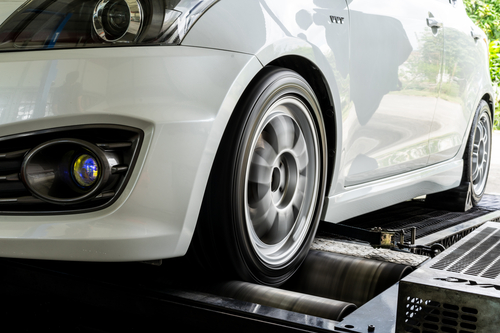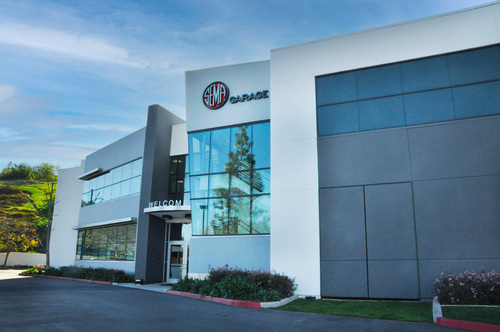BUSINESS
Is There Something in the Air?
EPA Enforcement, Compliance and What You Need to Know
By Daniel Ingber

Manufacturers, distributors and retailers alike are living in
fear of a dreaded EPA Notice of Violation or agents knocking
on their door.
There is something in the air and it smells like a shakedown. Ever since the Volkswagen diesel scandal broke six years ago, it seems like the government has set its sights on the automotive specialty aftermarket. You can’t open the newspaper without reading about another enforcement action or settlement.
Last year the Environmental Protection Agency (EPA) specifically said it was prioritizing “stopping aftermarket defeat devices for vehicles and engines” that override required emissions controls. No one expects things to get any better under the new administration.
Manufacturers, distributors and retailers alike are living in fear of a dreaded Notice of Violation or agents knocking on their door. Manufacturers and resellers of aftermarket performance tuners or parts for vehicle engine or exhaust systems are asking questions: What do I need to do to be left alone to run my business? How do I comply with the law when the rules seem to be changing all the time? How do I sell parts for race cars without the government coming after me? What can I do to help my company and the industry?
This article will answer these and other questions. Although this article is not intended as legal advice (after all, every company, enforcement action and situation is unique, and you should always consult your own lawyer), it does contain some legal talk. So bear with me here—I promise it won’t be so bad—and it may just help your company better navigate the tricky waters of emissions compliance.
The Legal Starting Point
Under the law, an aftermarket-part manufacturer cannot manufacture or sell products which defeat or tamper with the anti-pollution mechanisms of a vehicle. It will come as no surprise that the State of California was the first jurisdiction to establish emissions requirements for new automobiles—the California Air Resources Board (CARB) was formed in 1967, which pre-dated establishment of the Federal Air Quality Act of 1967. The Federal Clean Air Act (CAA) was passed in 1970, with major revisions in 1977 and 1990. Together, California and federal emissions law provides the legal framework for aftermarket compliance.
Manufacturers can demonstrate compliance with both federal and California law by receiving a CARB Executive Order (EO). Although the California Vehicle Code prohibits the sale of any part that alters or modifies a vehicle’s pollution-
control system, a part is exempt from this prohibition if it receives a CARB EO verifying a vehicle remains emissions-compliant with the part installed. As detailed below, one must submit an application to CARB and sometimes undertake lab testing to receive an EO for the part. A CARB EO is a golden ticket—neither EPA nor CARB will enforce against a part that has a CARB EO.
Clear as mud, right? Well, we haven’t even begun to talk about parts sold for race cars.

jobbers and some retail outlets because they are visibly
marketing a variety of products and may not be as
knowledgeable as the manufacturers in regards to CARB EOs
and certification obligations.
The Racing Angle
From the Clean Air Act’s inception, parts sold to convert street vehicles to vehicles used exclusively on the track fell outside the scope of the law. Of course, this makes perfect sense—a street vehicle converted for race use only (having attributes such as a roll bar, racing tune, etc.) and trailered to the track is no different than a purpose-built race car, and purpose-built race cars unambiguously fall outside of EPA jurisdiction.
In 2015, however, the EPA threw a wrench in the works, sneaking an interpretation into its rulemaking on an unrelated issue that would prohibit street-car to race-car conversions. That new interpretation would thereby prohibit the sale of parts that take a street vehicle out of compliance even if it became a track-use-only vehicle. Although the EPA quickly withdrew that official interpretation after a SEMA-led uproar—which included a White House petition that garnered more than 100,000 signatures—the EPA continues to stick to its guns. In fact, the agency has reiterated its position in recent enforcement litigation.
The EPA’s unreasonable interpretation of the Clean Air Act has sent a chill through the aftermarket and has manufacturers, distributors and retailers who sell parts for converted race cars looking over their shoulders. Even parts manufacturers who sell parts for dedicated, purpose-built race cars are worried that if their products find their way onto an outlaw street vehicle, they will be subject to enforcement. This is no way to treat a sector of the American economy that employs hundreds of thousands of people, generates billions of dollars in economic activity, and serves the needs of countless enthusiasts throughout the nation.
That’s why Congress needs to pass the Recognizing the Protection of Motorsports Act (RPM Act) ASAP. If you have been engaged with SEMA for the last few years, you probably already know what the RPM Act is. Still, here’s a refresher: The RPM Act reverses the EPA’s interpretation that the Clean Air Act does not allow a motor vehicle designed for street use to be converted into a dedicated race car.
Converting street vehicles into dedicated race vehicles is an American tradition dating back decades and has negligible environmental impact. The RPM Act will provide the racing community with certainty and confidence in the face of an EPA interpretation of the Clean Air Act that threatens to devastate an American pastime and eliminate jobs in our communities. That is why Congress must pass the RPM Act—now! Visit www.sema.org/rpmact.
Compliance Issues
For products intended to be installed on highway vehicles, the surest way to protect yourself from EPA/CARB enforcement is to obtain a CARB EO. Any product that affects airflow into or out of the engine, impacts the containment or delivery of fuel, or affects the functionality of an emissions control system or device must demonstrate emissions compliance to be considered legal for street use. This includes (but is not limited to) intake systems, exhaust components, tuning products, intercoolers, turbos and superchargers.
An application for a CARB EO is made with a test lab, which can test and evaluate the product, submit the application, and advocate for the product with CARB staff. To obtain a CARB EO, a manufacturer must submit an application that describes the product, its function and the range of vehicle fitment. Depending on the product’s complexity and potential impact, either an engineering evaluation or laboratory testing will be needed to demonstrate compliance. Testing requirements vary based on the type of product being tested. For example, superchargers and tuners must undergo more extensive testing than headers or air intake systems. The SEMA Garage operates a recognized testing facility, making it a viable option for member companies (see “Safeguarding Your Business,” p. 46).

either an engineering evaluation or laboratory testing will be
needed to demonstrate compliance. Testing requirements
vary based on the type of product being tested.
Federal Compliance
A CARB EO is required under the law to sell an emissions-related part in California. At the federal level, the Clean Air Act prevents the modification of vehicles with products that impact emissions unless the vehicle remains compliant (just like California). Under EPA policy, the manufacturer of an emissions-related product must have a “reasonable basis” to market the product as compliant.
The EPA’s testing guidelines were prohibitively onerous until the agency issued its new Tampering Policy (Nov. 23, 2020). The agency has now identified three ways a company can demonstrate a reasonable basis for concluding that the specialty part is compliant: 1) having an CARB EO; 2) having applied for a CARB EO; or 3) performing equivalent independent emissions tests. The SEMA Garage is currently developing services that will help manufacturers test their parts and produce data establishing reasonable-basis compliance. Although California would still require a CARB EO, reasonable-basis testing should help companies bring products to market faster than seeking a CARB EO (or while waiting for California to issue the EO).
EPA Civil Enforcement
How does the EPA “find” you? Enforcement staff regularly review aftermarket manufacturer, distributor and retailer websites and social-media content to identify products that may take a vehicle out of compliance with applicable clean-air standards. Marketplace competitors also provide tips and information. Investigators will look at claims made about performance enhancement and any listed limitations on the use of the product to identify potentially illegal products.
EPA enforcement investigations can be overly aggressive and very disruptive (or even destructive) to businesses. As an example, Susan Peachtree (all names have been changed to protect the innocent) owns a successful warehouse distribution company that sells thousands of products—from suspension accessories to superchargers to tuners—through its website and catalog. Peachtree’s EPA enforcement ordeal began with an unannounced visit. (Peachtree, knowing her rights, declined to grant the agents access to her facility.) She then received the dreaded “208 letter”—an official Request for Information under § 208(a) of the Clean Air Act which authorizes the EPA to investigate.
“I was in a state of shock when I received this letter,” said Peachtree. “It was 20 pages long and demanded information on hundreds of products—including SKUs, pricing information, advertising information, technical information… The scope was breathtaking—anything affecting OBD, exhaust, catalysts… The list goes on and on.”
Peachtree wisely hired an attorney to immediately begin negotiations with the EPA regarding the range of the request. Together they tried to persuade the EPA investigator that the list of parts being targeted, and the time period covered, were too broad and onerous. Because fines could be in excess of $3,750 per violation (now $4,819 per violation), the EPA was threatening Peachtree with a multi-million-dollar penalty. “Basically, the EPA was threatening to destroy my business,” she said, “a business I have spent my entire life building.”
“Most of the parts on the EPA’s list were completely benign,” her attorney told me, “and for months the investigator would not even discuss the issue. It was clear to me that the investigator did not truly understand the parts or the industry, and simply wanted to threaten my client with as high of a fine as possible.” The EPA continued to pepper Peachtree with invasive requests about revenue and finances. “I was living with a cloud over my head,” she recalled. “I was losing a lot of sleep.”
Finally, after a year and a half—and a lot of back and forth between Susan’s attorney and the EPA—the EPA settled the case for a low six-figure sum (representing a fraction of the initial settlement amount proposed by the EPA) and an agreement limiting the parts that Peachtree could sell. Between the fines, attorneys’ fees and the enforcement ordeal, her business barely weathered the storm. “I am lucky that I am still in business,” she said, “but the whole process left a very bad taste in my mouth.”
Mark Binkens (a pseudonym to protect his clients), an attorney who defends clients in EPA and CARB enforcement actions, summed it up this way: “This is how they do it. They threaten exorbitant fines that no company can ever pay. They wear you down with onerous information requests, ask for financial documents to establish your breaking point, and finally offer a settlement just shy of that breaking point. No one can afford to take them to court because attorneys’ fees add up so quickly and fines are so high that it isn’t worth the risk. It’s a shakedown.”
Binkens added an ominous observation regarding the EPA’s actions: “Through the process the EPA also gains access to all of your suppliers, manufacturers, customers and shops you are doing business with.”

worksite visits by EPA enforcement personnel. EPA employees
typically inform the companies they visit that they are carrying
out investigations and then provide business cards to identify
themselves. However, the enforcement teams usually provide
little or no other paperwork connected with, or explaining the
purpose of the visit.
Unannounced Visits
Some SEMA-member companies have even reported unscheduled worksite visits by EPA enforcement personnel. EPA employees have been informing the companies they visit that they are carrying out investigations and have typically provide business cards to identify themselves. However, the enforcement teams usually provided little or no other paperwork connected with, or explaining the purpose of the visit.
If EPA or CARB does investigate your business, SEMA strongly advises you to work with an attorney to respond. Initial missteps during an investigation can have long-lasting consequences. If an EPA or a CARB official visits your facility unannounced, company personnel should respond in a business-like manner. It is appropriate to request official identification and a business card. Let the officials know that company policy requires employees to first confer with top management and legal counsel before granting any access. Ask the official to provide a written request for the information being sought. Then call your lawyer. In addition, SEMA staff are available to assist member companies in understanding the investigative process and can provide a list of attorneys experienced in this area of law.
This article has covered a lot of ground and a number of complex issues. The bottom line is that emissions compliance is something that the EPA takes seriously. The agency has stepped up its enforcement. But now, hopefully, you’re up to speed and educated in the legal, compliance and enforcement basics that can help protect your business from the knock at the door.

test your part to obtain a CARB EO.
Safeguarding Your Business
How can you protect yourself against EPA/CARB enforcement? Below are things to think about.
My Company Manufactures or Sells Parts for Street Vehicles
- Obtain a CARB EO for any part that affects airflow into or out of the engine, impacts the containment or delivery of fuel or affects the functionality of an emissions control system (such as air intake systems, exhaust components, tuning product, intercoolers, turbos and superchargers). You can work with the SEMA Garage to design, develop, and test your part to obtain a CARB EO.
- If the part is not a performance or engine product (such as an aftermarket spoiler, rims, etc.), you can manufacture and sell it without worrying about EPA/CARB enforcement.
- A part can’t legally be sold for, or installed on, a street vehicle if the part can’t be engineered or designed in a way that maintains the function of a vehicle’s original pollution-control system (for example, DPF delete devices, racing tuners or cold air intake that increases emissions).
My Company Manufactures or Sells Parts for Competition Vehicles
- The Clean Air Act does not apply to parts manufactured and sold for street vehicles that have been modified to be track-only vehicles, but the EPA says otherwise. Help pass the RPM Act and save our race cars!
- In the meantime, know your customer. Document as much as you can that the vehicles you are manufacturing or selling for are race vehicles and have attributes such as roll bars, belong to a race team, or don’t have license plates.
- Ensure the number of units manufactured or sold supports sales that are for race-use-only vehicles.
- Do not rely on “For Race Use Only” labelling alone; it will not protect you from EPA enforcement.
- If you manufacture or sell parts for purpose-built race vehicles, the EPA probably won’t target you. Still, it’s possible, if highly unlikely, that if one of your parts ends up on a street vehicle the EPA will come knocking. “Trust us” isn’t good enough from the EPA: help pass the RPM Act.
- Be cognizant of your advertisements and social-media content. A viral video of a non-Clean-Air-Act-complaint vehicle doing burnouts on the street or a truck off-roading and belching out black smoke is an evidentiary “gift” to enforcers.
My Company Is a Distributor or Retailer
- Enforcement activities have targeted warehouse distributors, jobbers and some retail outlets because they are visibly marketing a variety of products and may not be as knowledgeable as the manufacturer about EOs and certification obligations.
- Ask your suppliers if their parts have CARB EOs and question them about a part’s legality.
- Advertise parts appropriately (for example, don’t show a license-plated vehicle on an advertisement for a race-use part) and be wary of claims made on websites (such as horsepower gains, etc.).
- Be mindful that based on the number of parts a distributor sells, fines can be extremely high.
 Emissions Testing at the SEMA Garage
Emissions Testing at the SEMA Garage
The SEMA Garage is available to assist with CARB EOs. It includes a CARB-recognized emissions laboratory for testing products at an affordable cost. The lab capabilities cover all tests (except evaporative testing when necessary) that may be required by CARB for the purposes of obtaining an EO for both gasoline and diesel vehicles. For more information on the SEMA Garage Compliance Center, go to www.semagarage.com or contact the staff at 909-978-6728 or garage@sema.org.
 Additional Resources
Additional Resources
 Clean-Air Compliance
Clean-Air Compliance
How SEMA Is Helping the Industry
By Daniel Ingber
 Compliance Testing and Education
Compliance Testing and Education
The SEMA Garage is available to help SEMA-member auto parts manufacturers with part design and demonstrate that a vehicle will remain emissions-compliant when the product is installed. The Garage’s Compliance Center includes experts and resources available to help members navigate the process, including evaluation of your product and recommendations for compliance procedures, assistance with the CARB EO process, interaction with CARB staff on your behalf, and review and evaluation of test data. SEMA also works closely with CARB and California lawmakers to ensure that testing procedures are fair and that EO applications are processed quickly.
SEMA also works with the EPA to assist our members in complying with the law. The EPA’s recent Tampering Policy, which will allow for more streamlined federal compliance, was a product of SEMA’s collaboration with EPA. SEMA also educates the EPA to dispel myths about the industry and to assist the EPA in setting enforcement priorities that do not unfairly target the aftermarket.
SEMA’s education programs help members comply with a complicated regulatory and enforcement landscape. SEMA’s February webinar on the EPA’s new Tampering Policy has been viewed more than 3,000 times (a SEMA record!), and the association has website resources on topics ranging from replica cars and vehicle titling/registration laws to state sales tax and Prop 65. Check SEMA eNews for new webinars and programs, and if you attend the SEMA Show this year, make sure to attend these two seminars: “Creating and Implementing an Effective Compliance Program to Manage EPA and CARB Risks,” and “Emissions Compliance: What You Need to Know,” which will include a panel of experts talking about EPA/CARB compliance and enforcement.
Fighting EPA Overreach
SEMA is leading the fight against the EPA’s overaggressive legal interpretations and enforcement tactics in the courts, the legislatures and the regulatory agencies. SEMA is determined to pass the RPM Act to correct the EPA’s misinterpretation of the Clean Air Act and allow racers to modify street cars into racing machines. SEMA also challenged the EPA in federal court on the assertion that a motor vehicle cannot be converted into a full-time race car. While the court did not address the issue directly, it did offer positive statements regarding the government’s burden of proof in such cases. Absent passage of the RPM Act or the EPA changing its position, this first-of-its-kind legal challenge is likely not the last.
SEMA is also leading the fight against overaggressive EPA enforcement. SEMA is asking the Office of Management and Budget, which oversees the regulatory process, to review and rein in the EPA’s use of unannounced site visits, government agents making overbroad or threatening statements, onerous demands for information, extortionate settlement demands, and other fear tactics employed by the EPA. SEMA will continue to oppose EPA overreach and protect the industry.
SEMA is committed to helping its members comply with the law and to influence the legal and regulatory compliance environment in a way that allows the industry to thrive. Through the SEMA Garage and Compliance Center, education programs, and working directly with the regulators and lawmakers, SEMA is easing the way for industry compliance.
Get Involved!
Being engaged with the government is an essential part of doing business as an aftermarket company. If you are a SEMA member, join the SEMA PAC and help SEMA throw its weight around Washington. Want to host a member of Congress at your company workplace? Let us know—SEMA helps arrange site visits. You can also represent the aftermarket and meet your lawmakers in person at the 2022 SEMA Washington Rally next May in D.C. Finally, every auto enthusiast should join the SEMA Action Network (SAN) to receive information about everything that affects enthusiasts and the industry, from the RPM Act to single license plate laws to military vehicle registration. The SAN is free, open to anyone, and a powerful tool to tell lawmakers what you think.






